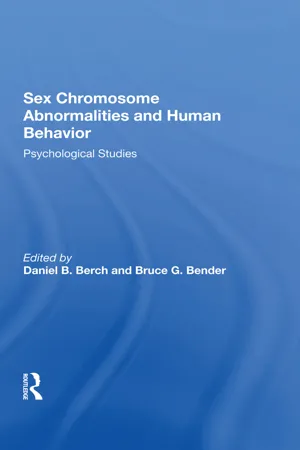Chromosomal Disorders
Chromosomal disorders are genetic conditions caused by abnormalities in the number or structure of chromosomes. These disorders can result in a wide range of physical and developmental abnormalities, such as Down syndrome and Turner syndrome. They are typically diagnosed through genetic testing and can have significant impacts on an individual's health and well-being.
5 Key excerpts on "Chromosomal Disorders"
- Amy E. Wenzel(Author)
- 2017(Publication Date)
- SAGE Publications, Inc(Publisher)
...For children who are born with chromosomal abnormalities, there is also a range of impact on functioning. Some children with chromosomal abnormalities do not have any serious problems. In fact, they may appear normal despite being at increased risk for infertility or of giving birth to children with genetic abnormalities. In this case, the individual may not even be aware of the abnormality until he or she undergoes genetic testing, gives birth to a child with a chromosomal abnormality, or has difficulty conceiving a child. However, other children born with chromosomal abnormalities experience physical, developmental, cognitive, and psychological problems manifested as distinct clinical syndromes. In fact, chromosomal abnormalities contribute to a significant number of developmental and intellectual disabilities. Clinical syndromes associated with autosomal chromosome anomalies include cri-du-chat syndrome, Down syndrome, Edwards syndrome, Patau syndrome, Williams syndrome, and chronic myelogenous leukemia. Turner syndrome and Klinefelter syndrome are clinical syndromes that result from sex chromosome anomalies. Treatment Although chromosomal abnormalities cannot be corrected in terms of changing the number or structure of chromosomes present, the associated health, developmental, behavioral, and cognitive problems may represent a target for treatment. Some chromosomal conditions may be treated with specific hormonal therapies to address associated physical differences or with medications to manage associated medical conditions. For example, growth hormone therapy and estrogen replacement therapy are often recommended to prevent short stature and promote sexual development in girls with Turner syndrome. A comprehensive treatment plan may also include mental health treatment to address mental health or behavioral problems...
- eBook - ePub
- Chang-Hui Shen(Author)
- 2019(Publication Date)
- Academic Press(Publisher)
...Chapter 13 Molecular Diagnosis of Chromosomal Disorders Abstract The DNA of an organism, with its arrays of genes, is organized into structures known as chromosomes which serve as carriers for transmitting genetic information. Cytogenetics means studying the number, structure, and function of chromosomes, the origin of chromosomal abnormalities, and the evolution of chromosomes. In this chapter, we discuss current cytogenetic techniques including the development of fluorescent techniques, which has led to the development of fluorescent in-situ hybridization (FISH), a technology linking cytogenetics to molecular genetics. FISH has a wide range of applications that increase the dimension of chromosome analysis, and it is particularly important for medical diagnostics. Furthermore, we discuss how the application of molecular techniques in cytogenetics, such as array-based technologies, has led to improved resolution, extending the recognized range of microdeletion/microduplication syndromes and genomic disorders. Furthermore, the association between visible chromosome rearrangements and defects at the single nucleotide level is also discussed...
- eBook - ePub
Mental Retardation
Nature, Cause, and Management
- George S. Baroff, J. Gregory Olley(Authors)
- 2014(Publication Date)
- Routledge(Publisher)
...3 CHAPTER Biological Factors in Mental Retardation: Chromosomal and Genetic □ Overview In the next three chapters, we explore the causes of mental retardation. The disorder may arise from biological factors, either operating fairly independently as in Down syndrome, a chromosomal disorder, or interacting with the psychological environment as in what earlier was called “cultural-familiar” mental retardation, now dubbed “psychosocial disadvantage” Biological determinants are presented in Chapters 3 and 4, and psychological ones in Chapter 5. The current chapter describes disorders created at conception—chromosomal and genetic. The topics covered are some basic biological concepts necessary to the understanding of chromosomal and genetic abnormalities, disorders of the nonsex chromosomes (autosomes), disorders of the sex chromosomes, and gene-determined conditions. □ Some Basic Biological Concepts About 15% of mental retardation is attributable to events that occur at conception (Crocker, 1992). These involve abnormalities of the chromosomes (10%), as in Down syndrome, or of the genes as in phenylketonuria (PKU) (5%). The genes, the units of heredity, are carriers of biochemical information to the cell, instructing it as to the kinds of proteins it will produce. Proteins serve as enzymes or catalysts of the body's biochemical reactions. A genetic disorder is, in essence, a biochemical error attributable to a deficiency in the enzyme necessary to a particular biochemical reaction. This is later illustrated with reference to PKU. It is first necessary to review some basic biological concepts so that we can have at least a general understanding of chromosomes and genes. Chromosomes Chromosomes are thread-like structures on which the genes are linearly arrayed. Chromosomes exist in pairs, with each pair structurally and genetically distinct from all other pairs (Fig. 3.1)...
- eBook - ePub
- Nessar Ahmed, Maureen Dawson, Chris Smith, Ed Wood(Authors)
- 2007(Publication Date)
- Taylor & Francis(Publisher)
...This is a mutation, and may eventually lead to disease because the cell is unable to make, for example, a particular enzyme, hormone, transporter or structural protein. Chromosomes have a complex structure (Figure 15.1). Each is comprised of a single double-stranded DNA molecule associated with numerous proteins. Figure 15.1 Scanning electronmicrograph of a chromosome. Courtesy of Dr C.J. Harrison, Christie Hospital, Manchester, UK. In general, chromosomes occur in matching or homologous pairs, with each member of a pair containing alleles or different forms of the same gene, which are found at the same loci (singular locus) in each member of the pairs. Normal human somatic (body) cells contain 23 pairs of chromosomes and are said to be diploid (2N). The 46 chromosomes in diploid cells comprise 22 homologous pairs of autosomes (nonsex chromosomes) and one pair of sex chromosomes; XX in females and XY in males (Figure 15.2 ; see also Figure 1.13). Oocytes and spermatozoa have half the diploid number and are said to be haploid (N) ; oocytes can only contain an X chromosome but sperm can have an X or a Y chromosome. Figure 15.2 The chromosome complement of a normal human male. That of a normal female is shown in Figure 1.13. 15.2 GENETICS AND DNA Genetics, from the Greek genno meaning ‘to give birth’, is that branch of biology concerned with heredity, genes and DNA (Figure 15.3), the genetic material. It is also the scientific study of the variations in inherited characteristics, often called traits, and how these are transmitted from one generation to the next. Inherited characteristics include a number of clinical conditions and diseases that are described in other chapters, for example sickle-cell anemia and hemophilia (Chapter 13), the muscular dystrophies and cystic fibrosis (Chapter 16). Others, such as phenylketonuria and Down syndrome, will be described in this chapter...
- eBook - ePub
Sex Chromosome Abnormalities And Human Behavior
Psychological Studies
- Daniel B Berch, Bruce G Bender(Authors)
- 2019(Publication Date)
- CRC Press(Publisher)
...1 Overview: Psychological Phenotypes and Sex Chromosome Abnormalities Bruce G. Bender Daniel B. Berch A remarkable breakthrough in the young science of cytogenetics occurred in 1956, when Tjio and Levan demonstrated that the diploid number of human chromosomes was 46, not 48 as previously believed. For the first time, the chromosomes could be seen and examined under a microscope, and the genetic cause of some birth defects identified. The presence of an extra chromosome in the twenty-first pair, trisomy 21, was found to underlie Down syndrome. Other autosomal aneuploidies, including trisomy 13 and trisomy 18, were linked to other identifiable syndromes, with physical malformations and mental retardation invariably present. Sex chromosome abnormalities (SCA) presented an intriguing contrast to autosomal abnormalities. Individuals with SCA demonstrated neither marked physical stigmata nor as diminished intelligence. Two known syndromes were found to result from SCAs. In 1959, an extra X chromosome (the 47,XXY karyotype) was documented in a man with Klinefelter syndrome (Jacobs & Strong, 1959). That same year, a missing X chromosome (the 45,X karyotype) was documented in a woman with Turner syndrome (Ford, Jones, Polani, De Almedia, & Briggs, 1959). In other cases, SCAs not previously associated with identified syndromes, including 47,XXX and 47,XYY, were documented. Questions of whether and how the presence of SCA affects ability and behavior quickly emerged, and a sizable literature of psychological and psychiatric studies evolved. Misunderstanding has surrounded much of this early behavioral research, and despite many efforts to sift through the conflicting conclusions, myths about SCA have persisted for 25 years. However, in the past decade, the use of more sophisticated methodologies has yielded a body of more objective data, enabling clearer interpretation of results...




